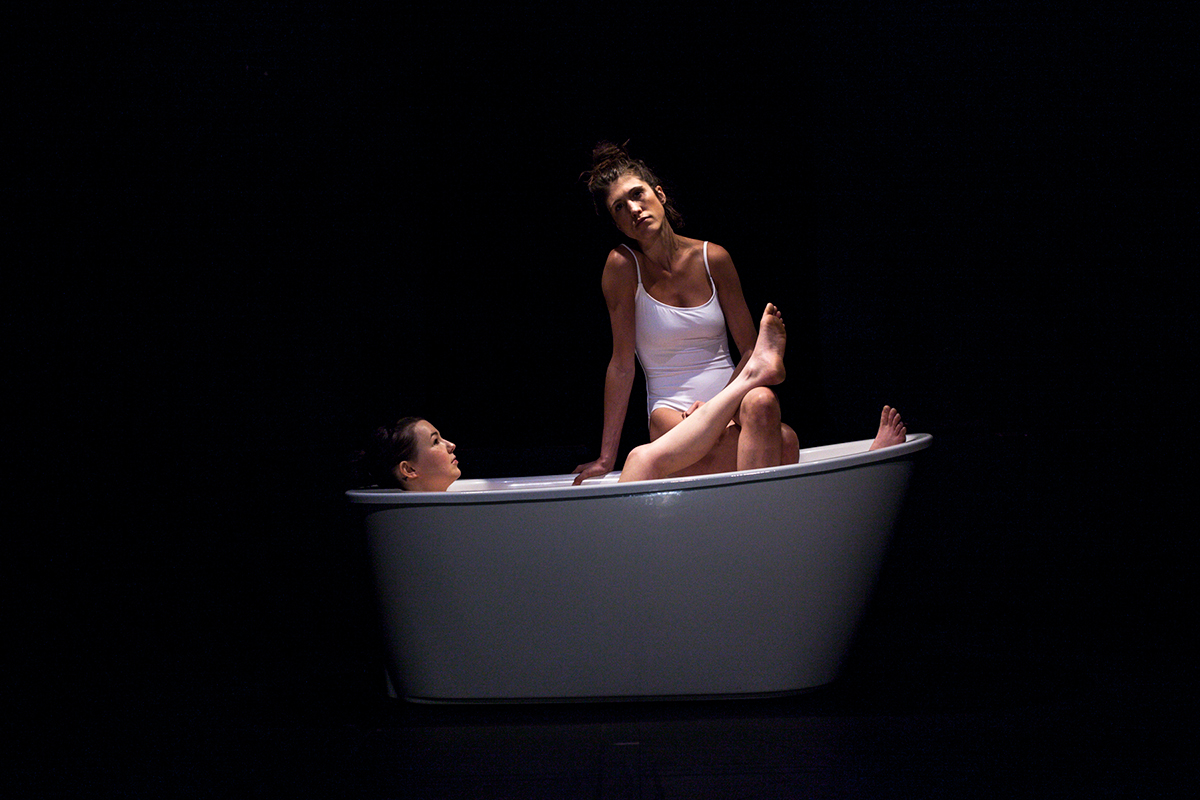‘My mother always told me you can cure almost anything with a hot bath.’
Two women in identikit white body suits sit in a white bath tub. Except it’s not two women, it’s one woman. A woman and her subconscious self. A woman and her inner child. A woman and her mother’s voice, which follows her around constantly, not just heard but also felt.
This woman is a modern woman of the world. She’s different to her mother.To the mother who has just died, and for whom a eulogy must be written. A eulogy written, a casket chosen, flowers ordered, a dress bought. And nylons too, perhaps. Our two-in-one woman rants against these tasks imposed upon her by her mother’s bereavement, and she rants against her mother – still the little girl who is trying to cut the apron strings. She is not like her mother. Not at all. Her mother was always neatly coiffed, immaculately dressed, beautifully made up. She has never, never ever, seen her mother eat French fries. Never, not once. She struggles to understand who her mother actually was. What did she do? What did she love?
Running through the show are continuous references to the white wedding that her mother never got to host. Maybe she’ll wear white to her mother’s funeral rather than black? Her mother was desperate to see her in a white dress in a church. Even as she plans the flowers for the funeral, bride’s bouquets seem not too far from her mind. Lilly of the valley. Baby’s breath.
The grief-stricken and angry and sulky and often hilariously funny rants and raves explode outwards, morphing into sobs and songs and screams. The two voices speak or sing as one voice, or in cannon, or in call and response. They mirror each other precisely, or overlap, or run just slightly out of synch, or in counterpoint. There is harmony, and there is dissonance. Much of the piece is a cappella, but there are interludes of recorded music with a rock or jazz or gospel vibe sung over or against.
The relentless outer-inner dialogue about the funeral arrangements is complemented by a number of set-pieces of feminist critique, for example, a great monologue on women’s voices and how high and low pitches are perceived and interpreted.
Mouthpiece is written and performed by Amy Nostbakken (who many UK audience members will know as the musical director of Theatre Ad Infinitum) and Norah Sadava, who are based in Toronto, Ontario in Canada. The women complement each other perfectly. Different heights and colourings, different talking and singing voices, very different performance qualities. It’s a physically robust show – exhausting just to watch these two excellent performers whose vocal gymnastics are matched by a gruelling choreography of physical actions in and around the bath tub – movement director/dramaturg Orian Michaeli, working with director Amy Nostbakken (who also composed the music), has done an excellent job in physicalising the voicework. The two women mirror, shadow, and see-saw; pushing, pulling, gyrating, supporting.
It’s not an easy ride, for performers or for audience: Mouthpiece is cathartic, disturbing, unnerving – but there are many moments of humour to counterbalance the intensity. It tackles a number of difficult subjects head-on: bereavement, especially when there are conflicted feelings about the dead person; the nature of the continuing insidious oppression of women in a hundred different small ways day in and day out; and the way that women collude in that oppression. Most of all, it tackles the one subject that many modern women find so immensely difficult to deal with: how do we make peace with our mothers, whether they are alive or dead?
Mouthpiece is presented at Edinburgh Fringe 2017 under the auspices of the Canada Hub programme at King’s Hall, in association with Summerhall and Aurora Nova.

